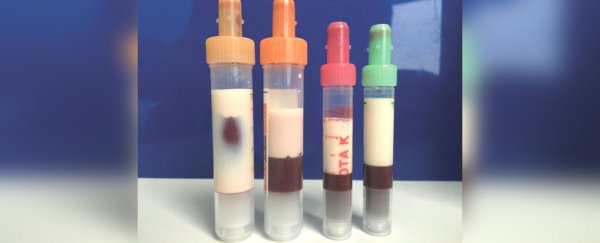A man in Germany had so much fat in his thickened, pale blood, it basically looked like milk, scientists report – and it could have killed him if doctors hadn't resorted to a long-abandoned treatment pioneered by ancient healers thousands of years ago.
In this case, the patient presented at hospital with what's known as extreme hypertriglyceridemia: a disease marked by high levels of fatty triglyceride molecules in the blood.
Ordinarily, doctors would treat this condition with a technique called plasmapheresis, which extracts blood plasma from the body, removes the excess triglycerides (or other toxic components), and returns the clean, filtered blood to the patient.
There was just one problem.
When doctors at the University Hospital of Cologne tried this approach with their 39-year-old patient, his extremely thick and fatty blood clogged their plasmapheresis machine. Twice.
When clinicians in the intensive care department hooked the man up to the hospital's plasmapheresis filter, his viscous, gluggy blood clogged up the equipment, and a second attempt became equally obstructed.
This bizarre case – something the researchers say they had never seen before – called for a different approach to somehow siphon the extreme and dangerous level of fat out of the man's blood.
A normal level of triglycerides in a person's blood would be less than 150 milligrams per decilitre (mg/dL), whereas a high reading would be between 200 to 499 mg/dL, and 500 mg/dL would be considered 'very high'.
In this instance, though, the patient's blood was completely congested, with his triglyceride count peaking at 36 times higher than very high, at about 18,000 mg/dL.
This, the researchers say, was why the man was experiencing nausea, vomiting, headaches, and deteriorating alertness when he turned up at hospital. All of these can be symptoms of what's known as hyperviscosity syndrome, where abnormally thickened blood can, in severe cases, trigger seizures and coma.
As for how the man had developed such an acute case, the researchers put it down to a number of related factors to do with his obesity, diet, insulin resistance, and a possible genetic predisposition – not to mention the fact that while he was on diabetes medication, he said he didn't always take it.
The doctors hypothesise that the patient's "cascade of events" could have been initially triggered by ketoacidosis, which had now developed into a particularly severe case - the virtually unresponsive man ranked just one point above a vegetative state on the Glasgow Coma Scale.
With plasmapheresis not possible, the doctors turned to a much older and now discredited option – a virtually forgotten treatment that largely hasn't been practised in mainstream medicine since the 18th and 19th centuries: bloodletting.
This ancient technique, which intentionally withdraws blood volume from the body, can be traced back as far as Ancient Egypt some 3,000 years ago, and was once one of the most common forms of 'medical' operation.
In those long ago times, however, medicine itself was an entirely different concept to what it is today, and these days bloodletting is mostly viewed as an anachronistic form of pseudoscience that caused far more harm than good to the patients being leeched (sometimes literally).
Which is not to say it doesn't have extremely rare uses – such as saving the life of a man whose blood is dangerously saturated with fat.
In the intensive care unit, the doctors ended up withdrawing two litres of the man's blood, replacing it with a supply of red blood cell concentrates, fresh frozen plasma, and a physiologic saline solution.
Despite the horror stories you hear about bloodletting, the remedy worked, successfully lowering the patient's triglyceride levels, and by day five, he was free of residual neurologic symptoms.
What's more, his medical team say this strange, possibly unprecedented case, demonstrates how bloodletting might still fulfil a weird niche in 21st century medicine – when no other options are available.
"If plasmapheresis can not be done due to extreme hyperviscosity, our experience demonstrates that conventional bloodletting with replacement [fluids] may be an effective alternative," the researchers explain in a case note on the man's treatment.
"To our knowledge, this is the first report to describe this procedure."
The findings are reported in Annals of Internal Medicine.
H/T: Live Science
